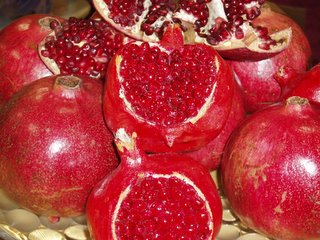(Warning: This is NOT a typical blog entry for Blog Appetit, but if you write a blog or enjoy reading blogs, you might want to spend a few minutes and read the below.)
I went to a forum tonight in San Francisco that was promoted as a
Food Blogger Face Off. Since I knew a lot of the people involved and knew they seemed to like each other just fine I figured that the name was some marketing hype. But how many tickets would have "meet the nice bloggers" sold?
I went with my friend, a food writing teacher and non-blogger. She felt she learned a lot, I was more ambivalent about what I learned, but the event (which featured super-bloggers Bruce of
Saute Wednesday, Pim of
Chez Pim, Heidi of
101 Cookbooks and Alder of
Vinography and was moderated by blog-savvy Amanda Berne of the
the San Francisco Chronicle) did prompt me to think a lot about blogs and blogging.
The turnout was large, about 130 people, which for a Monday night seemed huge. Virtually all of the audience raised their hands when asked if they read blogs. About a quarter indicated that they themselves blog. This panel was talking to pretty knowledgeable folk. Also, my friend pointed out the large number of men in attendance, which she says is unusual for a food event. She speculated it had to do with the technological appeal of blogging.
If you want, I'll be glad to do another post about what these very popular bloggers (101 Cookbooks gets 7,000 views a day) had to say about their blogging roots, concerns and passions. But right now I am just trying to process the thoughts the forum generated.
My disclaimer. I have no numbers. I have not polled anyone or done any surveys, scientific or self serving. These are my impressions and conclusions and are worth about what you paid for them.
First, Heidi referred to
bloggers as independent publishers, which fits well with my concept of the low economic barriers of entry for blogging. For many bloggers, it is just the cost of a computer and an internet connection. The spread of broadband has to help, too. I love being editor, publisher, photographer and writer. It reminds me of when I was a kid and used my father's old Royal typewriter and some carbon paper to bat out a neighborhood newspaper. It was too much work and despite the success of volume one, issue one there never was an second issue. Bloggers have cut out the information middlemen -- the traditional media -- and gone straight to their consumers/readers/viewers. They also don't need "news," they can write about the ordinary as well as the extraordinary. They don't need "man bites dog" to have something to share.
I also think many bloggers would blog even if they weren't sure their sites were being read. I know I did. Except for those bloggers who create their sites as marketing adjuncts, there is a yearning to communicate, to connect with other people and to share ideas and lives.
Next,
bloggers are the new story tellers. Every blog and every blog post tell a story. Every blogger has a point of view and is part of the group memory of the world we share. Bloggers and readers organize themselves into special interest niches (food blogs or whatever) which gives them a common language and experience. Instead of weaving an oral history, we are linking to each other and creating an archival one. Bruce of Saute Wednesday and Pim of Chez Pim both spoke of early versions of their blog entries wafting around the web, waiting to be plucked and read by anyone who creates a Google search with just the right words.
This is the power of life told in first person. As a former journalist trained in the "objective" third person, that is the biggest difference I see between writing for a blog and writing for a publication. Yes, print media has drifted from its mid-century conceptions of supposedly neutral writing into the first person thanks to the influences of Tom Wolfe and Hunter Thompson and celebrity interviews that are more about the interviewer's interaction with the famous person than the star him or herself. But this is different, this is truly first person. Early blogs were literally about "what I had to eat today." Or what I thought. Or what I thought about what I ate, etc. And without the tedious technology of typewriter and carbon paper, letterpress and ink, delivery trucks and the like, one could write and "publish" about what he or she ate today and have it read by one or one thousand even before the body had digested it.
This immediacy, this intimacy, this lack of barriers are what blogging and reading blogs are about. In the beginning, this was enough within a specific special interest category. Now, I'm told that blog readers appear to be more demanding in terms of content, with the rise of "hyper focused" blogs about sushi or burritos or taco trucks or whatever. I don't know about the appeal of single subject blogs over the more generalist ones (and you can't get more generalist than Blog Appetit) and I have some analogies that compare to the passing of more general interest magazines (such as Life) and the rise of more niche magazines, but I think it is more a reaction to two things.
1. There are more blogs to read that compete for the blog readers' attention and the novelty of first person eating descriptions is not enough to engender viewer loyalty and repeat visits. Your content has to be compelling, preferably in both subject and writing. What your blog looks like has become increasingly important. With the rise of easy-to-use templates, standards have risen. Suddenly blogs face the same problems as other media, how to rise above the clutter.
Having a focus your reader can instantly discern lifts you above the noise. Blog writing and blog reading have passed from the early adopters to a broader group of participants who are looking for more specific experiences than just the thrill of the simple existence of there being blogs and blog reading.
2. Blog readers (and RSS users) are in essence creating and editing their own magazines and cookbooks. They do it piecemeal as they click from source to source, link to link, bookmark to bookmark, regularly checking favorites and looking for new clicks for kicks. They never really create what you would consider a front page of a magazine, or have chapter headings or even have an index (who needs one when you can simply search for what you want with Yahoo, Google, etc.), but they are juggling content in their heads and their browsers. Any good magazine or cookbook needs a mix, a variety of article types and recipes. Blog readers are looking for new and different materials to fill out their mental media. By the end of the day they have created their own "mix tape" of blogs.
The next point is about the success of blogs. How many blogs do I see as I scurry around Blogger just checking things out that are just undisguised porn, finance or other unsavory commercial site masquerading as a blog? Or what about "blog farmers" who use other blogs' content to create sites that are designed more for generating ad revenue than readers? But it is not these phony blogs that could change the wide open world of blogging. The change will come from commercial success and influence.
When bloggers figure out how to make money with a blog beyond cookbook contracts and a few hundred dollars every month from Google's Adsense, then the impetus of having a blog has a major shift. Perhaps economic barriers will rise. Will Blogger and other sites continue to offer free hosting and tools if their users are making more money off their products than they are?
As more bloggers hire programmers (and perhaps content providers) to jazz up their sites to compete for readers, what will happen to the more home-grown sites without the money or talent to install the bells, whistles and real-time forums?
I know first hand how people in the food industry view the influence of food bloggers and I imagine it is the same in other niche blog markets. Virtually every vendor and manufacturer I met at the recent Fancy Food Show seemed as thrilled to talk to me about their products as they would be to someone from the traditional print media. I felt virtually no discrimination against me as a blogger, which I was very upfront about. I have begun to see and hear the interest of industry and commercial ventures in blogs. Will there someday be a "Betty Crocker" of a blogger, some made up corporate spokesbloggers whose carefully crafted first person accounts will be subliminally pushing us toward their products? What is the implication for such co-opting with politics? Do we have a blog police to flame these impostors? Do we trust to the free market and hope that an educated blogging public will be able to detect these frauds? Or does the line between blogger and website, personal and corporate become ever more blurred and a promising technology become commercialized and put out of reach of the masses?
The rise of the so-called Web2 technologies with their increased emphasis on interaction seems to me nothing more than traditional websites and commercial entities wanting to get what we bloggers have -- immediacy, flexibility, the ability to affect and motivate others, the interactiveness with our readers with comments and forums, the responsiveness, etc. Admittedly, I know little beyond what I read in the newspapers about Web2, but being a blogger, even one for just a few short months with a limited readership and using an off-the-shelf template, I can feel the pull of blogging's promise.
I used to wonder if blogs would end up like the CB fad in the late 70s. For a while it seemed everyone you knew had one or thought they should. CBers developed an ethos and lingo all their own. Then the fad began to fade. CBers had only each other to talk to in dwindling numbers as new technologies (such as car phones) and new interests replaced the CB. Within the blogging community there seems to be a concern that only people with blogs are reading other blogs and there is a concern that this is not healthy. I don't worry about it as much now. We still might be a fad or our success might drive out the original thought and writing, or without new readers we might slowly go away, but
we will live on through our permalinks, always just a Google search away.
Feel free to leave your comments on the past, present and future of blogging below.
 Baby it’s cold outside and the gas and electric meters are humming. We all look for ways keep down our energy bills and help the environment by conserving, but have you thought about ways to save while you cook? (Pacific Gas and Electric customers see the notes section below for information on how saving energy in the kitchen can help you earn you a rebate.)
Baby it’s cold outside and the gas and electric meters are humming. We all look for ways keep down our energy bills and help the environment by conserving, but have you thought about ways to save while you cook? (Pacific Gas and Electric customers see the notes section below for information on how saving energy in the kitchen can help you earn you a rebate.)











